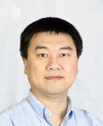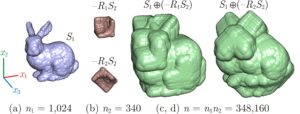Friday, November 18 • 2:30 PM – PWEB, Rm. 175
 Christopher White, Associate Professor of Mechanical Engineering
Christopher White, Associate Professor of Mechanical Engineering
University of New Hampshire, Durham, NH 03824
Abstract: Non-equilibrium wall-bounded flows, in which perturbation time scales are comparable to turbulent flow time scales, do not exhibit universal behaviors and cannot be characterized only in terms of local parameters. Pressure gradients, fast transients and complex geometries are among the sources that can perturb a flow from an equilibrium state to a non-equilibrium state. Since all or some of these perturbation sources are present in many engineering application relevant flow systems and geophysical flows, understanding and predicting the non-equilibrium flow dynamics is essential to reliably analyze and control such flows. This talk will describe zongoing work using complementary numerical and physical experiments to better understand the underlying physics, transition dynamics, and appropriate flow scaling in non-equilibrium, periodic wall-bounded flows. The overarching goal is to use the results from these scientific investigations to improve upon the robustness of engine computational fluid dynamics (CFD) models so that they can be used for engineering design of low emission, high-efficiency piston engines.
Biographical Sketch: Dr. White received his Ph.D. in Mechanical Engineering from Yale University in 2001. From 2001-2004 he was Postdoctoral Research Fellow at Stanford University. Following his post-doctoral work, he joined Sandia National Laboratories as a Senior Member of the Technical Staff in the Combustion Research Facility. His principal duties at Sandia included lead investigator in the Advanced Hydrogen Fueled Engine Laboratory. In 2006, he joined the Mechanical Engineering Faculty at the University of New Hampshire.
Dr. White’s research is broadly motivated by applications related to the production, storage, distribution, conversion, and end-use applications of energy. His research to date is of both fundamental and applied nature in the areas of combustion, piston engines, biomass, ocean energy, and turbulent drag reduction. His 2006 paper “The hydrogen-fueled internal combustion engine: a technical review” is designed as a Highly Cited Paper (top 1% in the field of engineering) by the Thompson Reuters Essential Science Indicators. He co-authored an Annual Review of Fluid Mechanics paper in 2008 titled “Mechanics and prediction of turbulent drag reduction with polymer additives”. In 2009, he received an NSF CAREER award to study the flow properties and rheology of liquefied biomass suspensions. He currently has funding from NSF, DOE, and ONR.
For additional information, please contact Prof. Ying Li at (860) 486-7110, yingli@engr.uconn.edu or Laurie Hockla at (860) 486-2189, hockla@engr.uconn.edu
 Yongming Liu, Assistant Professor
Yongming Liu, Assistant Professor
 ermal properties with microscale spatial resolution and sub-picosecond temporal resolution. Examples include: 1) TR-MOKE as a novel way to explore the origins of the anisotropic thermal transport in black phosphorus with enhanced measurement sensitivity; and 2) nanoparticle-assisted localized heating for probing interfacial thermal resistance at nanometer scales.
ermal properties with microscale spatial resolution and sub-picosecond temporal resolution. Examples include: 1) TR-MOKE as a novel way to explore the origins of the anisotropic thermal transport in black phosphorus with enhanced measurement sensitivity; and 2) nanoparticle-assisted localized heating for probing interfacial thermal resistance at nanometer scales. Design for Discovery: Structural Shape & Topology Optimization with a Level Set Approach
Design for Discovery: Structural Shape & Topology Optimization with a Level Set Approach



